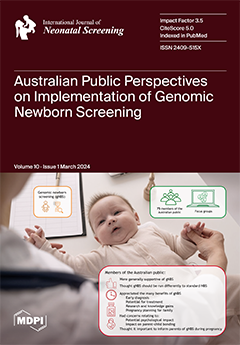Open AccessArticle
Future of Dutch NGS-Based Newborn Screening: Exploring the Technical Possibilities and Assessment of a Variant Classification Strategy
by
Gea Kiewiet, Dineke Westra, Eddy N. de Boer, Emma van Berkel, Tom G. J. Hofste, Martine van Zweeden, Ronny C. Derks, Nico F. A. Leijsten, Martina H. A. Ruiterkamp-Versteeg, Bart Charbon, Lennart Johansson, Janneke Bos-Kruizinga, Inge J. Veenstra, Monique G. M. de Sain-van der Velden, Els Voorhoeve, M. Rebecca Heiner-Fokkema, Francjan van Spronsen, Birgit Sikkema-Raddatz and Marcel Nelen
Cited by 8 | Viewed by 3460
Abstract
In this study, we compare next-generation sequencing (NGS) approaches (targeted panel (tNGS), whole exome sequencing (WES), and whole genome sequencing (WGS)) for application in newborn screening (NBS). DNA was extracted from dried blood spots (DBS) from 50 patients with genetically confirmed inherited metabolic
[...] Read more.
In this study, we compare next-generation sequencing (NGS) approaches (targeted panel (tNGS), whole exome sequencing (WES), and whole genome sequencing (WGS)) for application in newborn screening (NBS). DNA was extracted from dried blood spots (DBS) from 50 patients with genetically confirmed inherited metabolic disorders (IMDs) and 50 control samples. One hundred IMD-related genes were analyzed. Two data-filtering strategies were applied: one to detect only (likely) pathogenic ((L)P) variants, and one to detect (L)P variants in combination with variants of unknown significance (VUS). The variants were filtered and interpreted, defining true/false positives (TP/FP) and true/false negatives (TN/FN). The variant filtering strategies were assessed in a background cohort (BC) of 4833 individuals. Reliable results were obtained within 5 days. TP results (47 patient samples) for tNGS, WES, and WGS results were 33, 31, and 30, respectively, using the (L)P filtering, and 40, 40, and 38, respectively, when including VUS. FN results were 11, 13, and 14, respectively, excluding VUS, and 4, 4, and 6, when including VUS. The remaining FN were mainly samples with a homozygous VUS. All controls were TN. Three BC individuals showed a homozygous (L)P variant, all related to a variable, mild phenotype. The use of NGS-based workflows in NBS seems promising, although more knowledge of data handling, automated variant interpretation, and costs is needed before implementation.
Full article
►▼
Show Figures






